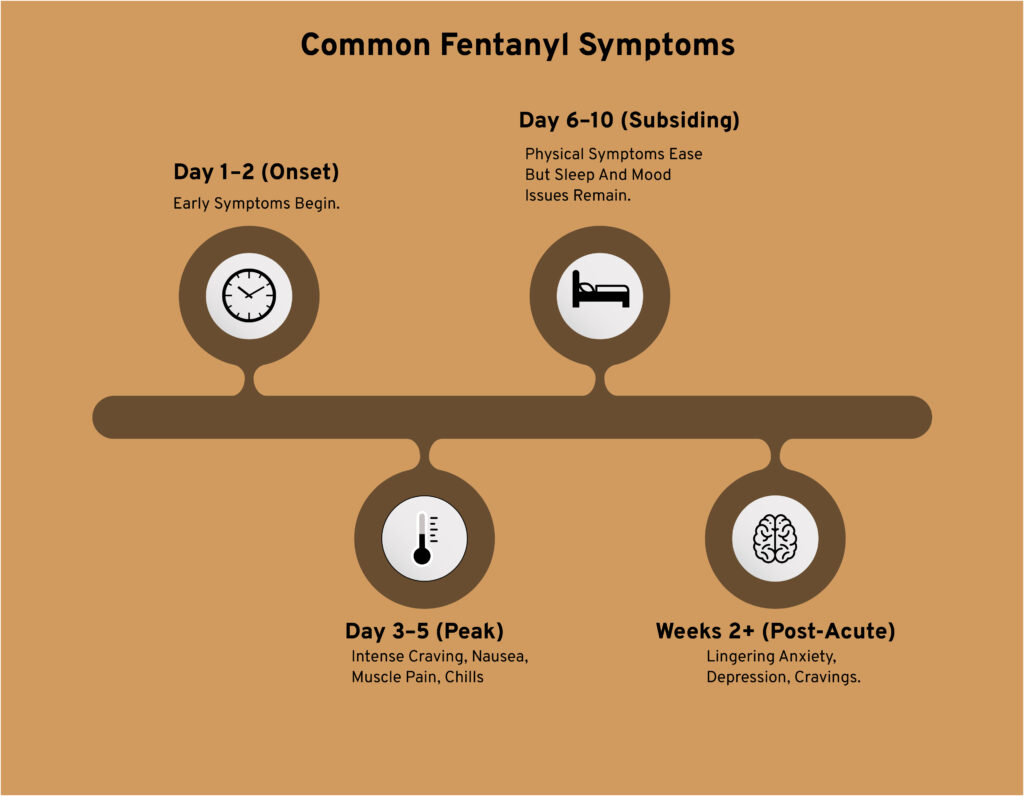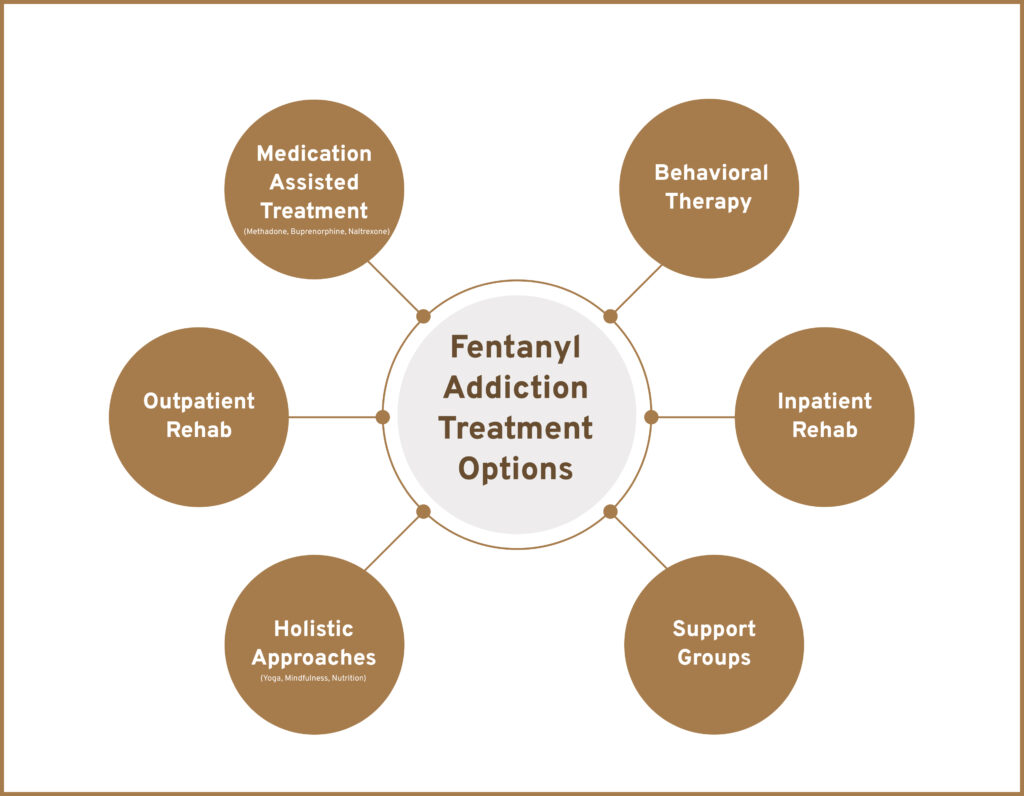Fentanyl is a synthetic opioid first developed to treat severe pain, often for cancer patients or those recovering from major surgery. Unlike natural opiates such as morphine or codeine, fentanyl is man-made in a lab and engineered to act faster and with far more power. It is estimated to be 50 to 100 times stronger than morphine and at least 50 times more potent than heroin (CDC). That extreme potency explains why dependence develops so quickly—and why withdrawal can feel so brutal.
It’s also worth noting the distinction between opioids and opiates. Opioids include all drugs, natural and synthetic, that act on the brain’s opioid receptors. Opiates refer only to naturally derived drugs from the opium poppy, like morphine and codeine. Since fentanyl is fully synthetic, it is an opioid, not an opiate—yet its strength makes withdrawal symptoms hit harder and faster than traditional opiates.
For someone using fentanyl, even a short break can send the body into chaos. Withdrawal feels like the worst flu you’ve ever had—multiplied by intense anxiety, restlessness, and relentless cravings.
Understanding what makes fentanyl withdrawal unique is the first step toward getting through it safely and finding the right treatment path.
How is fentanyl withdrawal different if not worse?
Fentanyl withdrawal is often described as harsher than withdrawal from other opioids.
One reason is potency: Fentanyl is 50-100 times stronger than morphine and binds tightly to the brain’s opioid receptors. This makes the body more dependent in a shorter amount of time, and when the drug is gone, withdrawal symptoms crash fast and hard,
Another factor is how fentanyl lingers in the body. Because it is stored in fatty tissues, it can be released unpredictably, prolonging withdrawal and making detox less straightforward than with heroin or morphine.
Doctors have also noted that fentanyl withdrawal can resist standard treatment. For example, some patients experience precipitated withdrawal, a sudden worsening of symptoms, when buprenorphine is given too soon. Precipitated Withdrawal in the era of street fentanyl study, found that people with fentanyl in their system were several times more likely to experience this kind of severe reaction
All of this means fentanyl withdrawal is not just “another opioid withdrawal.” It is often more intense, less predictable, and riskier to manage without professional help.
Withdrawal timeline for fentanyl, what to expect and when
For short-acting fentanyl, symptoms often begin within 8–24 hours after the last dose. Patch users may feel withdrawal a little later since the drug is released more slowly through the skin. Early signs can feel like the flu, restlessness, yawning, watery eyes, and anxiety.
The peak hits around Days 2–3, when cravings are strongest and physical symptoms like sweating, nausea, vomiting, diarrhea, and chills are at their worst. This is also the stage when relapse risk is highest, which is why support from a fentanyl detox center can make a big difference.
By Day 5–7, symptoms start to ease, though insomnia, mood swings, and cravings may continue. After the first week, many people enter post-acute withdrawal syndrome (PAWS), where emotional struggles like anxiety, depression, and irritability can linger for weeks or months.
So, how long do fentanyl withdrawals last? The worst symptoms usually pass within 7–10 days, but emotional recovery can take longer. Knowing what to expect can make the process less frightening and more manageable with the right support.

Common symptoms during fentanyl withdrawal
Fentanyl withdrawal is often described as one of the hardest experiences someone can go through. Because fentanyl is up to 100 times more potent than morphine, the body becomes dependent quickly and when the drug leaves the system, withdrawal symptoms can hit with brutal intensity overdose
Knowing what to expect is key for anyone wondering what are the common fentanyl withdrawal symptoms or searching for answers about the fentanyl withdrawal timeline.
Physical Symptoms fentanyl withdrawal
For many, the process feels like a flu that’s been amplified to extremes. Muscle aches and bone-deep pain make it hard to move or rest. Waves of sweating, chills, and goosebumps leave people shivering one moment and burning up the next. Flu-like signs such as a runny nose, watery eyes, and constant yawning often appear within the first 24 hours of withdrawal.
Digestive distress is another hallmark of fentanyl detox. Severe nausea, vomiting, and diarrhea can lead to dehydration and dangerous electrolyte imbalances if not treated. For people tapering off fentanyl patches, unique neurological symptoms sometimes appear, including muscle twitching, jerking movements (myoclonus), and spasms known as fasciculations.
These less-discussed symptoms highlight just how deeply fentanyl disrupts the nervous system.
Mental and Emotional Symptoms of fentanyl withdrawal
The emotional toll of fentanyl withdrawal is just as devastating as the physical. Anxiety and irritability often set in during the first day, while cravings intensify and make it hard to resist relapse. Many people also face depression and hopelessness as energy levels crash. Insomnia is common, leaving individuals exhausted at the exact moment when their body and mind need rest the most.
This mix of physical agony and emotional distress explains why people often ask, “Are fentanyl withdrawals worse than other opioids?” The answer is yes—because of its potency, fentanyl withdrawal tends to be more abrupt, more intense, and harder to manage without professional help.
At a fentanyl rehab or detox center, medical teams can ease symptoms, monitor health, and provide emotional support to make the process safer and more manageable.
Risks and clinical considerations for Fentanyl addiction
Fentanyl withdrawal may not always be deadly on its own, but going through it without proper medical support can be dangerous. The body is under extreme stress during detox. Severe nausea, vomiting, and diarrhea can quickly lead to dehydration and dangerous shifts in electrolytes.
For someone with an underlying heart condition, the rapid pulse and blood pressure swings that often come with withdrawal from fentanyl can make the process even riskier.
Another unique challenge is the danger of precipitated withdrawal. Because fentanyl binds so tightly to opioid receptors, starting medications like buprenorphine too soon can trigger an abrupt, severe withdrawal that feels unbearable. This is why timing and professional guidance are everything when it comes to fentanyl detox centers or medical-assisted treatment.
Perhaps the most serious risk, though, is relapse. During the fentanyl withdrawal timeline, cravings can be so intense that many people return to using just to make the pain stop. But after even a short break, the body’s tolerance drops. That means the same dose someone used before detox can now be deadly, greatly increasing the risk of overdose. Medical supervision, emotional support, and safe treatment planning are critical safeguards during this stage.
Post acute withdrawal for Fentanyl (PAWS)
Just because the worst physical symptoms fade after the first week doesn’t mean the battle with fentanyl withdrawal is truly over. For many, this is only the beginning of another phase called post-acute withdrawal syndrome (PAWS) , a stage that catches people off guard because it is less visible, but equally exhausting. Instead of body aches, chills, or nausea, PAWS is defined by lingering emotional and psychological symptoms. People often describe it as feeling like their mind and spirit are still in chains, even though their body is free.
Insomnia makes it hard to rest, and fatigue weighs heavily on daily life. Concentration becomes a challenge, while irritability and mood swings strain relationships. Perhaps the hardest symptoms are depression and anxiety, which can creep in quietly and make someone question whether recovery is even worth it. This emotional heaviness is part of why fentanyl recovery feels so overwhelming, it’s not just a detox of the body, but a slow healing of the brain.
The truth is, fentanyl changes brain chemistry so deeply that restoring balance takes time. The brain’s reward system, hijacked by such a powerful opioid, needs weeks or even months to recalibrate. During PAWS, it’s normal to feel like progress has stalled, but this stage is not failure, it’s simply part of the journey.
The good news is that healing does happen. With therapy, medical care, and support groups, and continued care at a fentanyl rehab program, these symptoms gradually improve, and the fog begins to lift. Many people find strength in realizing they are not alone, that others have endured PAWS and come out stronger. At a professional fentanyl rehab center, patients learn coping strategies, find encouragement, and regain a sense of hope. Understanding that PAWS is temporary, not permanent, can make all the difference in staying motivated.
Recovery from fentanyl isn’t just about surviving withdrawal; it’s about rebuilding a life that feels worth living again.
Practical tips to navigate Fentanyl withdrawal
Fentanyl withdrawal is not easy, it can feel like a battle between your body and mind. But small, intentional steps can make the process more bearable. Staying hydrated and eating light, nutrient-rich meals helps the body regain strength and prevents the exhaustion that comes from dehydration and nutrient loss.
Simple comforts, like warm baths, heating pads, or even a weighted blanket, can calm aching muscles and bring moments of relief. For those struggling with restlessness, gentle stretching or short walks can help release tension and quiet the body.
Sleep is often one of the hardest parts of recovery. Establishing a bedtime routine, keeping your room dark and cool, and cutting back on caffeine can improve the odds of getting some rest when insomnia hits hardest.
These small acts of self-care may not remove every symptom, but they remind you that your body is healing.
Most importantly, no one should face fentanyl withdrawal in isolation. Whether it’s leaning on loved ones, joining a support group, or entering a fentanyl detox center, having others by your side brings not only safety but also strength.
Knowing that countless people have endured withdrawal and come out stronger can provide hope on the darkest days. Recovery doesn’t happen alone, it happens together.

Treatments for fentanyl addiction
Detoxing from fentanyl is just the first step, it clears the body, but real recovery requires healing the mind and spirit too. The most successful treatment plans combine medical support, therapy, and long-term care to rebuild balance and reduce the risk of relapse.
Medication-assisted treatment (MAT) is often life-changing.
Medications like buprenorphine, methadone, and naltrexone reduce cravings, stabilize brain chemistry, and give people a fighting chance to focus on recovery instead of withdrawal. Alongside medication, therapy plays a powerful role. Cognitive behavioral therapy (CBT), trauma-informed counseling, and other evidence-based approaches help uncover the deeper reasons behind substance use and teach healthier coping strategies.
But treatment doesn’t end there. Many people find strength in peer support programs, inpatient rehab, and outpatient care, where accountability and encouragement come from those who truly understand the struggle. A strong aftercare plan can make the difference between relapse and lasting recovery.
At its core, treatment for fentanyl addiction is about more than just stopping the drug, it’s about rediscovering life, rebuilding connections, and finding hope in a future that feels possible again.
Ready to take the next step toward recovery? You don’t have to face this alone.
When do fentanyl withdrawals start?
Typically between 8–24 hours after the last dose.
How long does it take to detox from fentanyl?
Acute withdrawal peaks around 2–3 days, with symptom resolution over ~10 days. PAWS may last weeks.
Are withdrawal symptoms worse with fentanyl than other opioids?
Yes, because fentanyl is 50–100 times more potent than morphine, the body develops dependence more quickly. Withdrawal tends to be more abrupt, more intense, and longer-lasting compared to other opioids, which is why medical support is strongly recommended.
What are patch-specific withdrawal symptoms?
In addition to general symptoms, patch users may experience twitching, muscle jerks (fasciculations), and heightened pain responses.
Do I need medical help to get through fentanyl withdrawal?
While some people consider detoxing at home, fentanyl withdrawal is best managed under medical supervision. The symptoms can be overwhelming, and risks like dehydration, heart strain, and relapse are real. At a fentanyl detox center or rehab program, professionals can provide medications to ease symptoms, monitor your health, and offer emotional support. Having medical guidance not only makes withdrawal safer but also increases the chances of long-term recovery.
Do fentanyl side effects go away?
Yes, most side effects—like drowsiness, nausea, or constipation—fade when fentanyl use stops. However, withdrawal symptoms can temporarily feel worse before things improve. With treatment and time, the brain and body gradually restore balance.


